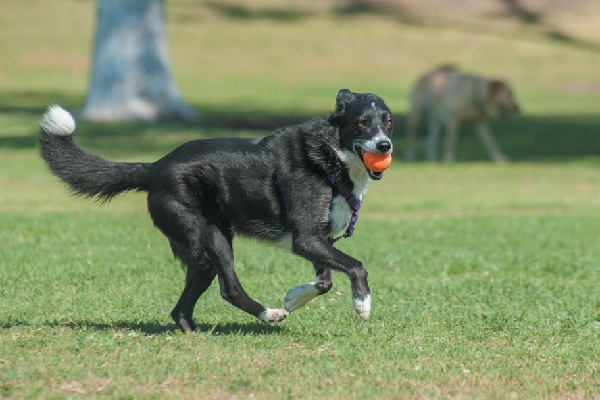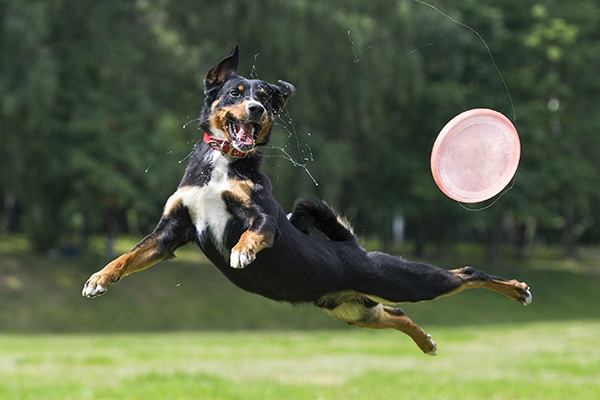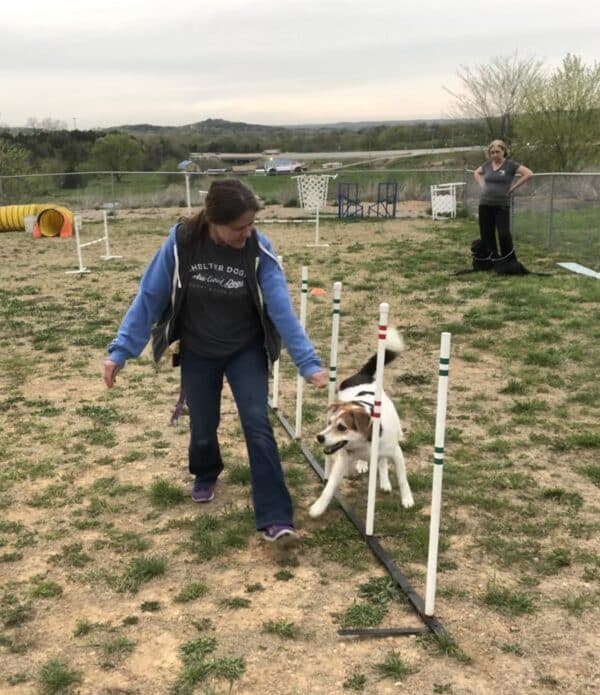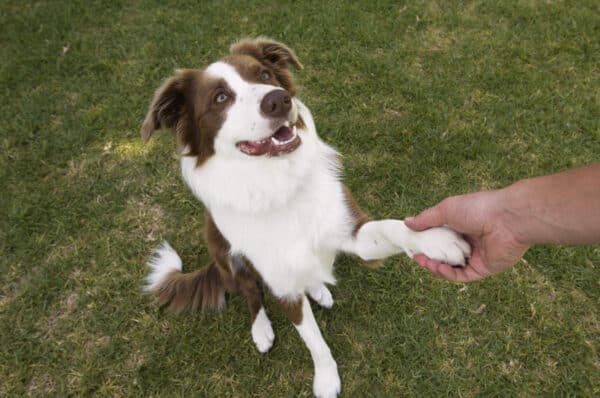I am working with an eight-month-old German Shepherd Dog who displays frantic behavior most of the time. Something is happening inside her body and brain that is beyond my reach in terms of effective training. As a professional dog trainer, I have successfully employed positive reinforcement training and behavior modification on hundreds of dogs with great successes. Not with this dog, though. She knows some basics, but if I ask for a skill outside of our training room — such as a simple sit or a hand touch — she is noncompliant, not because she is being stubborn or trying to dominate me, but because she seems overwhelmed by the world. She’s a hyper dog or an anxious dog — but there are steps you can take to modify the behavior of a hyper dog.
Inside the world of a hyper dog

This dog’s ability to focus on me is severely diminished by everything in her environment: other dogs, leaves falling from trees, prairie dogs and especially butterflies. I had hoped this puppy from working lines could become a search-and-rescue dog, but that was not in the cards. Too many things shut down her ability to hear me and to learn (other than learning how to be a great butterfly chaser). She gets a glazed look every time she meets something new, and then she often twirls or paces or even bolts from me. She also randomly sits up and barks at the other dogs from time to time as though she wanted to eat them — even when no other dogs are actually in the room.
Before I can focus on training this German Shepherd Dog, I need to calm down her overactive mind and fearful responses. I am willing to try anything on this hyper dog that would not hurt her, and anything that had a proven track record with veterinarians or other dog trainers using positive reinforcement.
What to know about calming a hyper dog
Luckily for dog owners everywhere, we are learning more about how dog’s minds work every day. We know, for example, that dog-appeasing pheromone (DAP), which mimics the scent of a lactating mother dog, is said to help calm about 80 percent of the dogs it is used on and is often used to help lessen separation anxiety. I’ve had great success with it as a good starting point with my clients’ dogs. Alas, it did not make a difference in this hyper dog’s behavior.
I love the Thundershirt, a snug wrap that can help with things like a fear of thunderstorms. I’ve used it (with owners’ permission) to help dogs calm down in busy kennels; it seems to be a miracle device for many dogs. However, it doesn’t help this hyper dog relax.
I asked fellow dog trainers to share their favorite remedies for calming a hyper dog. If you also have an overstimulated or hyper dog, I suggest you do one thing at a time and give it two weeks to a month before you add or switch out a remedy.
First, however, always rule out a possible medical concern. I paid $150 for lab work and I was relieved when the dog I was training got a clean bill of health.
The 5 Ways to Calm a Hyper Dog
1. Aromatherapy
Behavior consultant Marilyn Wolf of Korrect Kritters in New Port Richey, Fla., gives all her clients a handout that includes proven methods of calming a hyper dog down. She includes DAP, the Thundershirt, BACH Rescue Remedy (a popular flower essence mix for people and pets) and CALM Aroma Mist, which contains lavender and chamomile essential oils, which she sprays on her pants and on bandanas worn by the dogs. “The calming mist is the most popular item with our clients,” she says. “But there is something that we can all do for our dogs, and that is to calmly pet them when they are stressed. Long, slow strokes on the back (not the head) while the owner is calm and quiet does wonders.”
2. Herbal essences
Trainer Traci Moriarty of Wag Between Barks in Durango, Colo., recently worked with four extremely shy dogs of different ages, one of whom wouldn’t even leave his crate. “We used to do Terra aromatherapy oils, specifically Balance and Serenity,” she says. “A half hour before the class started the next week, I sprinkled both of these aromatherapy blends on every mat and on myself. The dramatic, positive changes in the dogs got all of our attention. I use these oils in all of my classes now.”
I tried these oils with the GSD puppy, and she did show some calmness, but not as much as I hoped to see nor as quickly as I wanted results. They did help me relax more around her, and they even helped me get calm enough to accept the situation for what it is instead of being depressed by it.
3. The Eye Contact Game
Trainer Laura Blanz of San Antonio, Tex., says her favorite training tool is Chris Bach’s Eye Contact Game, which she asks her students to teach their dogs at home before they even come to class.
“The beauty of the Eye Contact Game is that it is truly voluntary,” she says. “The dog learns to give up something he wants (food, in the teaching phase), and to attend to you, to get something he wants (again food, in the teaching phase). The dog’s decision to focus on you instead of the food is what produces the food reinforcement.” Your dog learns the skill of being calm and focused on you, which becomes a habit, and therefore self-reinforcing.
“Having your dog’s attention makes it much easier to teach additional new skills,” she says. “If the behavior is more complex and not responding to training, or the result of trauma or genetics, then I like to add homeopathy to the protocol.”
4. More calming techniques for a hyper dog
- Chinese veterinary medicine includes acupuncture, acupressure, Chinese herbs, and food energy therapy. Make sure you get this treatment from a veterinarian trained in these ancient healing arts.
- T-Touch: First developed for horses by Linda Tellington Jones, T-Touch is based on circular movements of the fingers and hands all over the body that activate cell function and awakens cellular intelligence. This calming method uses a combination of specific touches, lifts, and movement exercises that all work together to release tension.
- The Thunder Cap: Made by the same fine folks who brought us the Thundershirt, it filters visual stimulation, allowing dogs better concentration skills. It may look draconian but it can help a dog in a big way.
- Through a Dog’s Ear: Music therapy to help lower anxiety or calm a hyper dog! According to the website, this music “is psychoacoustically designed to support you and your dog’s compromised immune or nervous system.” I’ve gotten rave reviews from clients.
5. Anti-anxiety drugs from your veterinarian
Discuss doggie “Prozac” meds with your vet. I have seen anti-anxiety drugs work extremely well when combined with proper behavior modification, and current research backs this up. Sometimes this remedy is for the short run, sometimes it is for the long run. Each dog is different (just like us!) and so there can be some trial and error as your veterinarian and you determine which drug is helping your dog the most.
Of all of the calming techniques now available, my clients seem to resist this one the most. Please don’t take it personally if your vet recommends this for your dog — it is NOT a reflection on you as a dog parent or a failure of any kind. Remember: These calming drugs are for your dog and not for you! You’ll have to go to a human doctor to get your own supply.
Some final thoughts on calming a hyper dog
I am taking my own advice and using one treatment plan at a time with this hyper dog. I am now trying customized homeopathic remedies with an expert in the field, all while using massage and one-on-one quiet training time. She suggested we try iodine in teensy amounts to begin with. She interviewed me for more than an hour! I stopped the oils while this dog was taking a homeopathic remedy. My next step will be to give a calming mist a try, coupled with the Eye Contact Game.
I am grateful to the many positive reinforcement dog trainers who helped me. I need my village of support from other trainers as much as this dog does, so we have a standing appointment with a colleague (Kirsten Frisch of The Gentle Canine in Colorado) so that I can see progress being made and to give myself a break each week.
This GSD puppy challenges me on all levels, especially my patience, but I like a good challenge. She will make me grow as a human and as a trainer. I’ll give her the time and space she needs. As a famous horse trainer likes to say: “It takes the time it takes.” If you have a dog like this, please reach out to qualified and empathetic trainers, because we can definitely relate to your struggles!
Get even more tips on training a hyperactive dog here >>
Tell us: Have you ever tried to calm a hyper dog or an anxious dog? Tell us what worked for you in the comments!
Read more about dog training on Dogster.com:
- Do You Have a Stressed Dog? Let’s Talk Stress in Dogs
- How to Socialize a Dog Through Dog Training Classes & More
- 4 Tips for Finding a Good Playmate for Your Dog
About Annie Phenix: Positive-reinforcement dog trainer and author Annie Phenix never met a mountain she did not love, which explains why she lives in Durango, Colorado, and while she is always smiling since she is surrounded by mountains. She delights in the snowy season here, as do her five dogs, two horses, and six adorably cute donkeys.
July is the CHILL ZONE on Dogster.com! Learn how to keep your dog cool, calm and collected this summer with articles on preventing summer mishaps, staving off stress and more.
Featured Image Credit: vikarus | iStock / Getty Images Plus.





